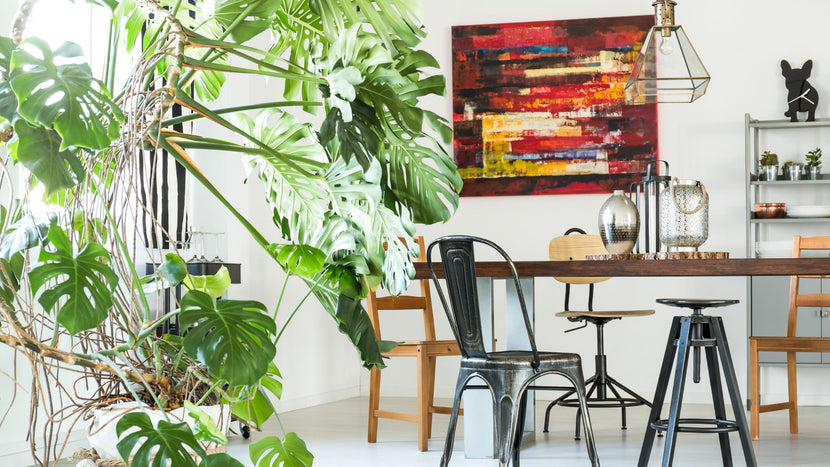How to Grow Monstera Plants as House Plants
Plant Guide

Monstera plants are native to the rainforests of Central America. The Monstera deliciosa or Split-leaf philodendron is a popular, easy-to-care-for indoor plant. It's a staple of interior designers for both residential and commercial spaces due to its exciting foliage and low-maintenance requirements.
Indoors philodendron plants have a moderate growth rate and grow about 1 to 2 feet a year with support. The glossy, heart-shaped, split leaves grow on stems often covered with aerial roots, which the plant uses to attach itself to poles and trellises. Monstera adansonii is also called the Swiss cheese plant because of its perforated leaves borne on vines that can reach 3 to 4 feet long.
Ground Rules
Light
Monstera plants grow naturally in shaded areas under the dense forest canopy. Therefore the plants have naturally adapted to gathering all the available ambient light that the forest floor allows.
In the outdoors, sunlight does not typically come from one direction but rather from all directions, through sunlight reflections off the surrounding plants. When grown in our homes, plants mostly get light from the windows. The inside of our homes is much darker than the shade outside.
Monsteras prefer bright, indirect light that can often be found near an eastern or western facing window. Too much bright, direct sunlight during the summer months can burn the large leaves. Monstera plants can be moved outdoors on either a shaded patio or deck on a covered porch during the warmer spring and summer months.
If you notice the leaves of the monstera plant beginning to turn yellow, this is often a sign the plant is receiving too much direct sunlight. Move the plant to another location with less direct sunlight, and this will fix the problem. Yellowing leaves can also signify not having enough light, but this is rarely the case with tropical plants. Either way, moving the plant around and finding the perfect spot is the fix for both problems.
Water
Water your monstera plant regularly during the growing season, at least every one to two weeks, depending on your location and humidity levels in your home. Water until the excess water drains through drainage holes of the pot. Do not be tempted to put the excess drainage water back into the plant's soil because it has taken all the water it needs. The soil should dry out slightly between waterings.
In the fall and winter months, the Monstera will require less frequent watering. It is also recommended during this period to increase the humidity levels surrounding the plant. This can be done simply by misting the foliage using a spray bottle of spring water or rainwater, if available.
Soil
In the tropical rain forests where Monstera plants grow naturally, their specialized roots grow into the soil and around trees as they climb, allowing them to cling to the trunks and branches. Monsteras are naturally suited for an environment with lots of humidity and high airflow; therefore, they grow best in soil that is well-draining but also retains moisture. Monstera plants absorb oxygen through their roots, so providing both air and water to the root zone is essential to the health of these plants.
Eventually, your monstera plant will need to be re-potted. Prescribing a soil mix for your plant is not as easy as just saying "use this commercially available potting soil" and being done. For us, we have found that a 50/50 blend of Espoma Organic Potting Mix and Espoma Organic Cactus mix works well.
If you tend to water too often, we advise adding Espoma Organic Perlite to this mix as well. This will allow the soil to drain faster and allow air to penetrate the soil.
Monstera plants can develop root rot if the soil stays too wet, so good drainage is essential. To aid in good drainage, we suggest a deep pot with large drainage holes in the bottom that allow excess water to drain. A layer of coarse gravel on the bottom of the pot will keep the drain hole from becoming blocked. If your pot has a saucer make sure to empty the saucer after watering.
Food
There are several ways to fertilize Monstera plants. The most popular and preferred way of fertilizing Monstera is by using a liquid fertilizer. We recommended a balanced 20-20-20 water-soluble fertilizer such as Jacks' Classic All Purpose Fertilizer. This fertilizer is easily mixed into water and is easily absorbed by the plant.
Once per month during the spring and summer is plenty, but it can be used at each watering but should only be mixed at 50% of the recommended rate.
Another way that you can feed Monstera plants is by using a slow-release granular fertilizer such as Osmocote Indoor/Outdoor fertilizer. Sprinkle this onto the soil surface at the recommended rate, and each time you water, the correct amount of fertilizer will be released and made available to the plant.
Toxicity
Unfortunately, your Monstera is poisonous to your furry friends. The reason why they are toxic is because of the insoluble calcium oxalate crystals found in the plant. It is in the leaves, stems, and roots. If your cat or dog gets into this plant, it is unlikely that it will be a fatal interaction. However, it is still crucial to keep all contact at a minimum to ensure there are no problems. Some symptoms to look out for include: excessive drooling, pawing at the mouth, oral irritation, vomiting, etc. Check out our Pet-Safe Houseplant section to ensure you are bringing home the best plant for your family.
Should I Mist My Monstera Deliciosa Plant?
How do you propagate Monstera Plants?
Should I prune my Monstera Plant?
Types of Monstera Plants:
| Scientific Name: | Common Name: | Image: |
|---|---|---|
| Monstera deliciosa | Split Leaf Philodendron |  |
| Monstera adansonii | Swiss Cheese Vine |  |
| Rhaphidophora tetrasperma | Mini Monstera 'Ginny' |  |
